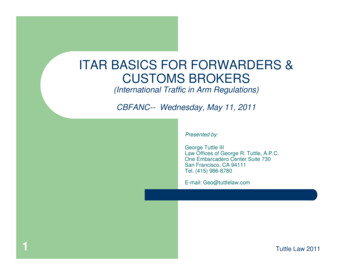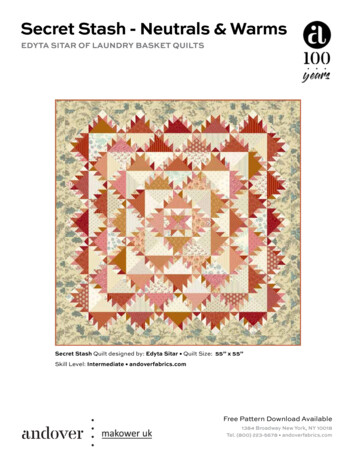
Transcription
ITAR Compliance Best Practices GuideEmail: Sales@Aurorait.comPhone: (888) 282-0696Website: www.Aurorait.com1
Table of ContentsExecutive Summary & Overview3Data Security Best Practices4About Aurora 10Email: Sales@Aurorait.comPhone: (888) 282-0696Website: www.Aurorait.com2
Executive Summary & Overview:International Traffic in Arms Regulations (ITAR) is a set of US Government regulationsthat deals with the export and temporary import of defense articles and services.ITAR regulations dictate that information and material pertaining to defense and militaryrelated technologies, including technical data may only be shared with U.S persons. Thisincludes but is not limited to technology pertaining to satellites and launch vehicles, softwaredeveloped for the management and use of military applications. Basically, ITAR governs thepeople, data and systems involved in arms and defense manufacturing and contracting.Penalties for ITAR Violations include: Criminal fines for corporations or individuals of up to 1million per violation and/or imprisonment of up to ten years for willful violations. Civil penaltiesfor corporations and individuals include fines up to 500,000 per violation relating tounauthorized exports of defense articles/defense services and Debarment from export ofdefense articles or defense services.Being ITAR compliant is really about having a good data security strategy and defensivetechnology implementation in place. On a basic level, this strategy will address the accessrequirements (Only U.S persons can have access to ITAR information), the exporting ortransmitting limitations (Defense information cannot be exported or transmitted to nonauthorized personnel without explicit permission from the Federal Government) and theinternal security requirements (ITAR governed businesses need to do due diligence and investin the security of ITAR regulated information).Email: Sales@Aurorait.comPhone: (888) 282-0696Website: www.Aurorait.com3
ITAR Compliance Data Security Best Practices:What can organizations do to protect data with regards to ITAR compliance? We listed ashort, summarized list below that can help organizations with ITAR compliance through somedata security best-practices. It is important to understand that data security is not an endresult, but a continuous journey in protecting your information assets. We implement solutions,test and validate our security by third parties and constantly fine tune our security posture,while enabling business units to function optimally. Sound more like an art form than a science?It can be.We’ve listed a few best-practices below that can help you get started on your journey:Security Policies & Incident Response Procedures:An ITAR specific security policy is the foundation of a data security practice and strategy.However, this is not a check box or one time deliverable, but a living, breathing document--asthe business environment changes, so do the policies and the strategy. These policies shouldaddress physical and network security considerations as well as incident response procedures.The best-intentioned security measures cannot guarantee that we will not be breached.However, in the event of a breach, a good incident response program can be the differencebetween a quick remediation or a costly data breach. The policies and incident responseprocedures should be tested and validated annually. Lastly, the policy documents also functionas a baseline for employee security awareness training, also a critical component to ITARcompliance and addressed in more detail further in this guide.Next Generation Firewall:Attackers are getting more and more sophisticated. Several of them are now organized andsponsored by nation states. Smart, agile perimeter security is vital for ITAR compliance and forprotection from savvy hackers and ever changing threat vectors. Traditional firewalls are a thingof the past. Perimeter firewalls today have to provide advanced threat defense from malware,viruses, and zero day attacks as well as provide traditional firewall functionality. Some of thenew functionality to look for is sandboxing (for Malware protection), IPS/IDS functionality,Email: Sales@Aurorait.comPhone: (888) 282-0696Website: www.Aurorait.com4
some SIEM (Security Identity and Event Management) functionality, Application Protection, aneasy GUI based management and easy incident response capability. If our security team cannoteasily identify, manage and respond to attacks, a highly complex firewall can truly work againstus. Look for complexity in functionality, but ease in ongoing management of next generationfirewalls.Data Classification:All data is truly not created equal. We are all concerned about Data theft, be it credit cardinformation, healthcare (PHI) information or private and confidential employee data or tradesecrets. In recent cases, we have heard a lot about corporate espionage and hacking threatsfrom competing nation states. Well, how do we go about protecting our information assetsfrom data thieves?In most cases, a combination of Data Classification, Data Leakage Prevention and Encryptionwill get you there. Data classification is a pre-requisite to a successful Data Leakage Prevention(DLP) implementation. Before we can protect our data from leaking, we need to classifyinformation into some iteration of the below four categories: 1) Public Use, 2) Internal UseOnly, 3) Confidential and 4) Top Secret.In order to accomplish this task: We usually scan the environment (data discovery) for key words and phrases andcontent that the business unit deems confidential and at risk.Email: Sales@Aurorait.comPhone: (888) 282-0696Website: www.Aurorait.com5
This information is identified and consolidated initially. It’s a lot easier to safeguardassets in 1-5 locations, rather than if they were spread out all across the network. Once the data is consolidated, appropriate protection and data security (data at restencryption for example) measures can be applied to the data or the devices it resideson.From that point on, all the information assets can be tagged appropriately (Example: PublicUse, Internal Use Only, Confidential and Top Secret). The organization can then set policies fordata in use and data in motion. A Data Leakage Prevention (DLP) solution can then follow thepolicies we set to protect data from leaving the organization or getting into the wrong handsinternally as well.In conclusion, for an effective data security strategy, we really have to lay the foundationthrough a data classification exercise, and then follow it up with data security measures like DLPand Encryption.Data Leakage Prevention:There are three employee scenarios that a properly implemented DLP solution can protect youagainst: The well-meaning insider: This is the accidental leak. The innocent employee who madea mistake. Someone emailing themselves, or taking data home to work on it, mentioningwhat they do or worked on their social media page, leaving a USB device or smart phoneat the coffee shop, etc. Malicious Insider: The employee that didn’t get the promotion he/she thought theydeserved, or just a trouble maker trying to leak information, or someone working for thecompetition or a foreign state (in the case of ITAR specifically). Malicious Outsider: Competitors, enemy states, corporate espionage, hackers, etc fallinto this category.Email: Sales@Aurorait.comPhone: (888) 282-0696Website: www.Aurorait.com6
Once data is appropriately tagged, we can then have DLP protect it from all three scenarioslisted above. Lastly, if sensitive data does need to leave the organization for valid businessreasons, it needs to be encrypted.Data Encryption:Encryption policies must be in place to effectively secure all types of data including: Data at Rest (Laptops, desktops, USB Devices, Offsite Backup, Databases, etc.) Data in Motion (Emails, File Transfers, Web Traffic, etc.) Data in Use (SharePoint, Private Cloud, File & Application Servers, Database, etc.)Email: Sales@Aurorait.comPhone: (888) 282-0696Website: www.Aurorait.com7
Encryption can usually work in conjunction with DLP to provide holistic data security and policyenforcement. Once we’ve determined that ITAR data needs to legitimately leave theorganization, and we confirm that it is going to the intended U.S person, we can enforceencryption of the data, so only the intended recipient can access and read the information.Multi-Factor Authentication:Something you know (password) and something you have (token, soft token, smart phone,etc.). At some point in the near future, all sensitive online accounts will require multi-factorauthentication. From our online banking institutions to our ITAR applications at work; Multifactor authentication makes it much harder for a hacker to access sensitive and top secretinformation. It’s possible to steal credentials in the form of static and weak passwords but arandom generated token for 2-factor authentication makes hacking just ones password useless.These token can now be received on phones, so we no longer need to carry physical tokenswith us and risk losing them.Identity & Access Management (IAM):Identity is the ‘Who’ – who needs to have access to this information and from which authorizedsystems. In the IT world, we refer to this combination of people and systems as your digitalidentity. Now we know who you are and where you’re accessing the information from.Email: Sales@Aurorait.comPhone: (888) 282-0696Website: www.Aurorait.com8
Access is the ‘What’ – what information do they need to access. It includes the individual’s role,permissions and security restrictions come into play as well. The correct combination of Identityand Access Management can help a great deal with ITAR compliance.We can ensure that only the authorized U.S individuals are accessing information that theyneed to have access to, from pre-authorized systems, and nothing more. IAM paired with multifactor authentication can make it very difficult for a hacker to access ITAR governedinformation solely by compromising an employee’s network password.End User Security Awareness Training:You are as secure as your weakest link. And that unfortunately is us – people, employees, endusers, execs, managers, bosses – whatever our role may be in the organization. Invest in enduser training, annually if you can, biennially if you have budgetary restrictions. Onsite, live,interactive training is usually the most beneficial. The trainee gets the opportunity to askquestions, delve deeper into a specific topic if needed, and it helps with overall attention span.Online trainings are also available for new employees, but not as an alternate to the live ones. Atrained employee can help avoid a data breach which can cost millions. End user training can beeffective towards proactive security versus reactive security which again is much more costly.Prevention is truly the best option here, and end user training is a huge step in that direction.In conclusion, this is not a guide for 100% ITAR compliance. However, the goal is to build a securityfoundation to protect against ITAR violations and security breaches. The threat landscape changesevery second and our goal is to provoke thought and to provide an easy to understand checklistto get us started. If some of the above foundational security elements are not in place, it wouldmake it very difficult for us to prove that we did our due diligence to be ITAR compliant or toprevent a data breach from occurring.Email: Sales@Aurorait.comPhone: (888) 282-0696Website: www.Aurorait.com9
About Aurora For over 20 years, security-conscious companies have turned to Aurora Enterprises’professionals for support of their business critical applications. Our experienced team ofsecurity experts helps our clients to conquer the complex challenges of data security. Aurora’sServices, Sales and Software teams combine to uniquely position the company as a singlesource, full service solutions provider to enterprises and government agencies.Aurora is a national 8(a) certified and Disadvantaged /Minority Business Enterprise(DBE/MBE), for information security software, hardware and consulting services. Aurora provides enterprise-class security consulting services at a mid-market price. Our securityassessment services are centered on Application Security, Network Security and EndpointSecurity. From quick Vulnerability Assessments to deep dive Security Strategy Development,our security professionals include practical recommendations with a holistic approach toinformation privacy. Aurora specializes in implementing solutions that cover Web Security,Email Security, Application Security and Data Encryption. We protect both the network as wellas the Endpoint, providing our customers end-to-end security and easy management.Aurora currently holds 11 state contracts for IT products and services. Aurora is asecurity cleared entity with a focus on helping our Federal Government in their cyber securityinitiatives. We are especially proud to have both Civilian and Department of Defense agenciesas customers. All our current contracts and certifications can be viewed and downloaded athttp://www.aurorait.com/government/Email: Sales@Aurorait.comPhone: (888) 282-0696Website: www.Aurorait.com10
Prevention is truly the best option here, and end user training is a huge step in that direction. In conclusion, this is not a guide 100% ITAR compliance.for However, the goal is to build a security foundation to pr










